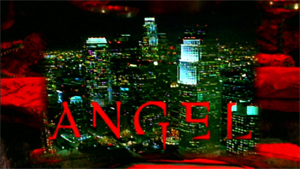Related Research Articles

Buffy Anne Summers is the title character of the Buffy the Vampire Slayer franchise. She first appeared in the 1992 film Buffy the Vampire Slayer before going on to appear in The WB/UPN 1997–2003 television series and subsequent 1998–2018 Dark Horse and 2019–present Boom! Studios comic series of the same name. The character has also appeared in the spin-off series Angel, as well as numerous expanded universe materials such as novels and video games. Buffy was portrayed by Kristy Swanson in the film and by Sarah Michelle Gellar in the television series. Giselle Loren has lent her voice to the character in both the Buffy video games and an unproduced animated series, while Kelly Albanese lent her voice to the character in the Buffy the Vampire Slayer Season Eight motion comics.

William "Spike" Pratt, played by James Marsters, is a fictional character created by Joss Whedon and David Greenwalt for the television series Buffy the Vampire Slayer and Angel. Spike is a vampire and played various roles on the shows, including villain, anti-hero, trickster and romantic interest. For Marsters, the role as Spike began a career in science fiction television, becoming "the obvious go-to guy for US cult [television]." For creator Whedon, Spike is the "most fully developed" of his characters. The character was intended to be a brief villain, with Whedon originally adamant to not have another major "romantic vampire" character like Angel. Marsters says "Spike was supposed to be dirty and evil, punk rock, and then dead." However, the character ended up staying through the second season, and then returning in the fourth to replace Cordelia as "the character who told Buffy she was stupid and about to die."

Angel is an American supernatural television series, a spinoff of Buffy the Vampire Slayer. The series was created by Buffy's creator, writer and director Joss Whedon, in collaboration with David Greenwalt. It aired on The WB from October 5, 1999, to May 19, 2004, consisting of five seasons and 110 episodes. Like Buffy, it was produced by Whedon's production company, Mutant Enemy.

Faith Lehane is a fictional character created by Joss Whedon for the television series Buffy the Vampire Slayer. Played by actress Eliza Dushku, Faith was introduced in the third season of Buffy and was a focus of that season's overarching plot. She returned for shorter story arcs on Buffy and its spin-off, Angel. The character's story is continued in the comic book series Buffy the Vampire Slayer Season Eight, and she also appears in apocryphal material such as other comic books and novels. Faith was set to receive her own spin-off television series after the final season of Buffy, but Eliza Dushku declined the offer, and the series was never made. The character later co-stars in the 25-issue comic book Angel & Faith beginning in August 2011 under the banner of Buffy the Vampire Slayer Season Nine, the story taking place mostly in London and the surrounding area. Seven years after the character's creation, Whedon granted her the surname Lehane for a role-playing game and subsequent material. The last issue of Season Eight was the first source officially confirmed to be canon that referred to Faith by her full name.

Fray is an eight-issue comic book limited series, a futuristic spin-off of the television series Buffy the Vampire Slayer. Written by Buffy creator Joss Whedon, the series follows a Slayer named Melaka Fray, a chosen one in a time where vampires are returning to the slums of New York City, and the rich-poor divide is even greater. Volume one is drawn by Karl Moline (pencils) and Andy Owens (inks).
The Buffyverse or Slayerverse is a media franchise created by Joss Whedon. The term also refers to the shared fictional universe in which the TV series Buffy the Vampire Slayer and Angel are set. This term, originally coined by fans of the TV series, has since been used in the titles of published works, and adopted by Joss Whedon, the creator of the fictional universe. The Buffyverse is a place in which supernatural phenomena exist, and supernatural evil can be challenged by people willing to fight against such forces. Much of the licensed Buffyverse merchandise and media, while being official, is not considered to be canon within the universe.

Cursed is an original novel based on the television series Buffy the Vampire Slayer and its spin-off Angel.

Spike: Asylum is a five-issue comic book limited series based on Angel television series. It was released from September 2006 through January 2007. The five issues were collected together in a single trade paperback in May 2007.
The fictional universe established by television series Buffy the Vampire Slayer and Angel and the film Buffy the Vampire Slayer has been parodied or paid tribute to by a number of unofficial productions, most notably fan films and adult films.
The popular fictional Buffyverse established by TV series, Buffy the Vampire Slayer and Angel has led to attempts to develop more commercially viable programs set in the fictional 'Buffyverse'. However some of these projects remain undeveloped for various reasons: sometimes, vital cast members may be unavailable; alternatively, studios and networks which would provide capital for the spinoffs might remain unconvinced that such projects are financially viable.

Buffy the Vampire Slayer Season Eight is a comic book series published by Dark Horse Comics from 2007 to 2011. The series serves as a canonical continuation of the television series Buffy the Vampire Slayer, and follows the events of that show's final televised season. It is produced by Joss Whedon, who wrote or co-wrote three of the series arcs and several one-shot stories. The series was followed by Season Nine in 2011.

"The Long Way Home" is the first arc from the Buffy the Vampire Slayer Season Eight series of comic books, a direct continuation of the television series of the same name. It is written by creator Joss Whedon. It ran for four issues. The first issue was released on March 14, 2007, and the final issue of the arc was released on June 6, 2007. A collected edition of the arc was released on November 14, 2007.

"The Chain" is the fifth issue of the Buffy the Vampire Slayer Season Eight series of comic books, a continuation of the television series of the same name. It is written by creator Joss Whedon. It is dedicated to the late Janie Kleinman, a network executive whom Whedon worked with and admired.

Angel: After the Fall, also known as Angel: Season 6, is a comic book published by IDW Publishing. Written by Brian Lynch and plotted with Joss Whedon, the series is a canonical continuation of the Angel television series, and follows the events of that show's final season. Angel: After the Fall was prompted by IDW Publishing and Joss Whedon after the success of Dark Horse Comics' Buffy the Vampire Slayer Season Eight which is the official comic continuation of Angel's mothershow, Buffy the Vampire Slayer. Angel: After the Fall sees the heroic vampire, Angel, coping with the apocalyptic aftermath of the television series after he took over and subsequently betrayed the demonic law firm, Wolfram & Hart. The city of Los Angeles has since been sent to hell by Wolfram & Hart as a result of Angel's actions. The series follows his attempts to rescue the people he has sworn to protect. The first issue was released on November 21, 2007.

"Twilight" is the seventh story arc of the Buffy the Vampire Slayer Season Eight series of comic books, based upon the television series of the same name, and is written by novelist and comic book writer Brad Meltzer. The story follows Buffy's warfare with recurring villain Twilight, and features Buffy taking on Twilight mano y mano following her development of powers similar to his. Part II, notably, reveals the identity of Twilight after months of speculation; this revelation was leaked early due to cover solicitations, leading to much early controversy and speculation, as well as damage control from showrunner Joss Whedon and Dark Horse Comics editor Scott Allie.

"Time of Your Life" is the fourth story arc that spans the sixteenth to nineteenth issues of the Buffy the Vampire Slayer Season Eight series of comic books, a continuation of the television series of the same name. The story, written by Joss Whedon, is a crossover with Whedon's earlier Buffy spin-off, the graphic novel Fray (2001-2003), "Time of Your Life" features artwork by Fray co-creator Karl Moline.
Spike is a comic book series published by IDW Publishing. Written by Brian Lynch, it focuses on the character of Spike, a main character in television series Buffy the Vampire Slayer and its spin-off, Angel. Uniquely, although this is a spin-off from IDW's larger Angel: After the Fall franchise, it also serves as a prequel to Dark Horse Comics' own Buffy the Vampire Slayer Season Eight comic book series. As such, it is "canon" to the overall "Buffyverse" in which stories take place. Although originally intended as an ongoing series, the Angel rights transfer from IDW to Dark Horse caused the series end after eight issues.
References
- ↑ See Star Trek canon, Star Wars canon. These canons have been more clearly defined than the Buffyverse canon.
- 1 2 3 Faraci, Devin, Exclusive Interview: Joss Whedon, CHUD.com (September 22, 2005)
- ↑ Brady, Matt, "Joss Whedon talks Angel, After the Fall Archived April 29, 2007, at the Wayback Machine ", Newsarama.com (April 26, 2007).
- 1 2 3 4 Naso, Markisan, Jeff Mariotte: Cursed Archived June 13, 2007, at the Wayback Machine , Silver Bullet Comic Books (2005)
- ↑ Allie, Scott "An Interview with Scott Allie Archived October 13, 2007, at the Wayback Machine ". Stakesandsalvation.com (May 16, 2007)
- ↑ Whedon, Joss "Joss to never learn how to work site!". Whedonesque.com (November 09 2005)
- 1 2 Rudolph, Ileane,"Buffy the Vampire Slayer Is Back: The Complete Joss Whedon Q&A". TV Guide (December 7, 2006)
- ↑ Nazzaro, Joe, "Interview with Joss Whedon", Starburst #48 (June 2001). Cited from fanficcafe Archived November 23, 2005, at the Wayback Machine .
- ↑ Whedon, Joss, "Chosen", Buffy TV episode (2003)
- ↑ Golden, Christopher & Sniegoski, Thomas E., Monster Island , Pocket Books, (March 2003)
- ↑ Whedon, Joss, "Conviction" Angel TV series (2003).
- ↑ Bratton, Kristy, "Behind the Scenes with Christopher Golden Archived December 5, 2005, at the Wayback Machine ", Cityofangel.com (2000).
- ↑ Bratton, Kristy, "Dragon*Con 2000 Archived January 9, 2007, at the Wayback Machine ", Cityofangel.com (2000).
- ↑ David, Peter, "Spike Comic", Peterdavid.malibulist.com (March 12, 2005).
- ↑ Barrera, Rachel, "City of Angel – Jeff Mariotte: Armed with Pen and Stake Archived 2004-12-21 at the Wayback Machine ", Cityofangel.com (2000).
- ↑ Hsiao, James T. (archiver), "Bronze VIP Archive Archived 2014-12-20 at the Wayback Machine " The Bronze (January 17, 1999).
- ↑ Lynch, Brian (2007-07-27). "Comments on 13845: (SPOILER) First smidgen of info from IDW's 'Angel:After the Fall' panel at Comic-Con" . Retrieved 2007-07-31.
- ↑ Ervin-Gore, Shawna, "Dark Horse; Joss Whedon Archived February 11, 2008, at the Wayback Machine " darkhorse.com (2001).
- ↑ Topping, Keith "Slayer". Virgin Publishing , (December 1, 2004), p7
- ↑ Ken, P., "An Interview with Joss Whedon Archived 2006-07-27 at the Wayback Machine ", filmforce.ign.com , page 10 (June 23, 2003).
- ↑ Wight, Eric (2003). "Sunnydale High School Library: Visual Development". Ericwight.com. Archived from the original on 2 April 2007.